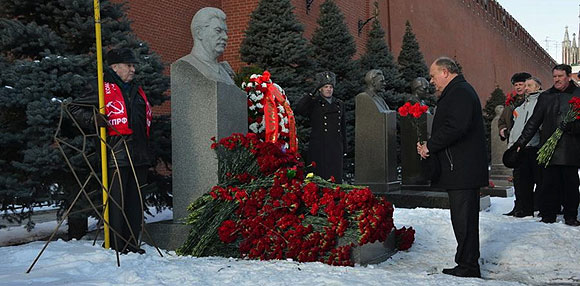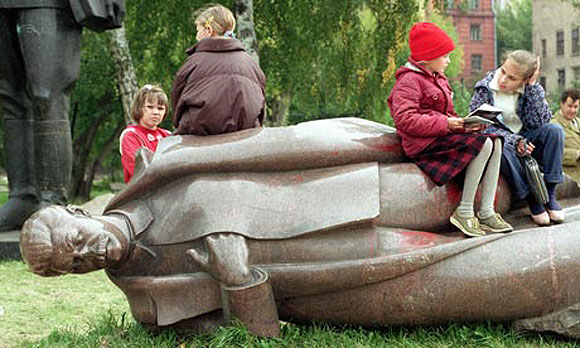(imrussia.org) Monday, 11 March 2013 8:54 PM
Hundreds of people laid carnations on Stalin’s grave in Red Square, where his body was buried in 1961 after it had lain next to Lenin’s in a mausoleum for over eight years. Communist Party leader Gennady Zyuganov praised Stalin as a symbol of Russia’s “great victories” and said that Russia needs to draw on his “unique experience” in order to overcome its problems today. The Communist daily Sovetskaya Rossiya ran a cover story on Stalin entitled “His Time Will Come.”
Stalin’s image is widely used on Victory Day, the date on which Russians celebrate the end of World War II, but, as observers note, “the 1930s-era purges, the murderous collectivisation of the peasantry, and the feared network of Gulag camps that together claimed millions of lives are largely absent from public discourse.” Moreover, the Communist Party has collected 100,000 signatures on a petition to restore Volgograd’s postwar name, Stalingrad. (That German officials today would express similar nostalgia for the Third Reich is almost unthinkable.) Nevertheless, a sizeable minority of the Russian public sees Stalin as a dictator whose crimes have yet to be fully acknowledged. The cover of the liberal Moscow News on Tuesday proclaimed, “Stalin. Farewell” and depicted his face scribbled over with graffiti. On few other issues—including the assessment of Mikhail Gorbachev’s role in the death of the USSR and Russia’s tumultuous years after 1991—are Western and Russian views so divergent.
The discord over Stalin’s role reflects a deeper conflict over how Russians see themselves. “The two views of Stalin,” according to Masha Lipman of the Carnegie Moscow Center, coexist in equal measure, split between the “public perception of Stalin as both a tyrant to blame for the deaths of millions and a wise and powerful leader who won the war against Hitler. In the minds of many Russians, in fact, the two perceptions are commonly combined.” The poet Anna Akhmatova, who lost her husband in Stalin’s camps and whose son spent 14 years there, wrote that after Stalin’s death “the two Russia’s faced each other—those who went to prison and those who sent them there.”
The discord over Stalin’s role reflects a deeper conflict over how Russians see themselves.
A new report by Lipman and three other colleagues published earlier this month by the Carnegie Endowment finds that support for Stalin has actually increased since the fall of the Soviet Union. Stalin is today the uncontested leader on Russians’ list of great historical figures, placed ahead of Lenin and Peter the Great. The Carnegie report offers several reasons for this “Stalin Puzzle”: support for Stalin may be more of a reflection of dependency and confusion than genuine support for dictatorship; Stalin is still admired as a wartime leader, especially among the elderly; and de-Stalinization has been a half-hearted effort. Lev Gudkov, president of the well-regarded Levada Center and a coauthor of the Carnegie report, believes that Stalin’s continued popularity is partly due to disappointment with political liberalization. Stalin, he argues, is a symbol for the perceived failings of liberal democracy. According to Gudkov, the biggest rise in Stalin’s reputation occurred after Putin came to power in 2000 and “launched a comprehensive program to ideologically reeducate society.”
The Carnegie report contends that Putin has deliberately manipulated Stalin’s image to reinforce his effort to build a “power vertical” in Russia. The Russian president has generally abstained from public criticism of Stalin. He and his team have minimized the high human cost of the Gulag, forced collectivization, and industrialization. Putin has restored Soviet-era symbols and focused on “achievements” during that era rather than Stalin’s crimes. Many Russians have been angered by government-sponsored textbooks that portray Stalin in a largely positive light, stressing the leader’s “effective management” of the 1930 industrialization campaign.
Putin’s appointment of controversial historian Vladimir Medinsky as Minister of Culture has faced particular criticism and sparked concerns that state-enforced “patriotism” is on the Kremlin’s agenda. Medinsky, the author of numerous works of “history,” has been accused of dubious scholarship, plagiarism, and propaganda. One of Medinsky’s favorite topics is World War II. He claims that Soviet troops never really invaded or occupied Poland or the Baltic States, but only “incorporated” them. Medinsky believes that only 10 percent of returning Soviet prisoners of war were sent to the Gulag, a conclusion rejected by almost all other historians, and that a photo showing Soviet and German troops together celebrating their joint victory over Poland in Brest-Litovsk on September 22, 1939, was “photoshopped.”
Stalin is losing his power to attract or repel Russians who are more urbanized, self-sufficient, and critical of their county's history.
To be sure, President Putin has made a few attempts to honor Stalin’s victims. Most notably, in October 2007, he attended a memorial service at the Butovo shooting range near Moscow, the second-largest Soviet-era execution ground, where more than 20,000 people—including peasants, factory workers, Czarist military officers, Russian Orthodox clergymen (most notably Metropolitan Seraphim (Chichagov) of Leningrad), German Communists, writers, invalids, and even Moscow’s Chinese launderers—were shot between 1937 and 1938 at the height of Stalin’s Great Terror. Putin used the occasion to urge that political arguments be “creative rather than destructive.” The visit seemed half-hearted to many human rights observers, however, because an August ceremony to erect a shrine to victims was not attended by any Kremlin officials and fell during a Duma election campaign.
 |
| Gennady Zyuganov, leader of the second-largest party caucus in the Russian parliament, does not hide his admiration for Stalinism. |
From the beginning, some Russians tried to forget. After World War II, an apple orchard and strawberry patches were planted over the dead buried at Butovo. It was said that the fruit grew unusually large there. The government gave the property to the Russian Orthodox Church in 1995, but, with the exception of the religious celebrations held by the Patriarch every year, the district—now dotted with flowers and birch trees—is often empty, and few schoolchildren visit. Much construction has occurred in the area in recent years, transforming Butovo into a comfortable and convenient place to live that is popular with Moscow’s middle-class businessmen and, it is said, mafia bosses.
The Carnegie report finds that, despite continued argument over the Great Dictator, Russian society displays a growing indifference toward Stalin, especially among young people. Stalin is losing his power, the report concludes, to attract or repel Russians who are more urbanized, self-sufficient, and critical of their country's history. However, given a regime today that so frequently relies on Stalinist symbols and habits of governance—though it is both unwilling and unable to embark upon the dictator’s totalitarian path—the decision to sweep aside the question of Stalin’s role in Russian history is unlikely to lessen its enduring influence.












No comments:
Post a Comment